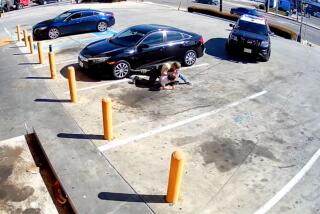Defense motions denied in attack case
- Share via
The judge in the trial of 10 black youths accused of beating three white women in Long Beach on Halloween night rejected six defense attorneys’ pleas Tuesday to throw out the charges against their clients because of what they characterized as incredibly thin evidence.
Pleas at this stage of a trial, before the defense has challenged prosecution evidence, are not unusual. But because a judge in juvenile proceedings, not a jury, decides the guilt or innocence of the defendants, the rulings could suggest that Judge Gibson Lee believes the prosecution’s case, taken alone, is strong enough to lead to convictions.
Lee’s rulings came despite one defense attorney’s impassioned argument that the only evidence against his client, a 12-year-old girl, was a statement from a witness that she saw her “throwing newspapers around at the girls.” The seventh-grader is charged with three counts of assault with intent to inflict great bodily harm. She has been in custody for more than two months.
Defense attorney Tom Harmon noted that the witness said she observed the newspaper tossing from 300 feet away, while his client was standing on a dark street among hundreds of people.
“That’s a football field,” he said. “From that vantage point she’s able to see my client quote-unquote throwing newspapers around at the girls? That’s just not believable.”
Deputy Dist. Atty Andrea Bouas did not dispute that the statement was the only evidence against the 12-year-old. But Bouas argued that Lee should believe Kiana Alford -- the prosecution’s key witness. “She’s an earnest person, she is very credible, and she saw.”
The judge listened to Harmon and Bouas, then turned to John Schmocker, the defense attorney next up to make a motion to dismiss, and mumbled, “Motion denied, Mr. Schmocker.”
Of the six motions to dismiss made Tuesday, the judge did not contemplate any one for more for than several seconds before denying them. More are expected today.
The 10 defendants -- nine girls and a boy ages 12 to 17 -- were charged with the assaults, and eight with hate-crime enhancements, in the mob beating, which left the victims with serious injuries, including multiple facial fractures. Three of the minors have turned 18 while the charges were pending.
No one disputes that the defendants were at the scene of the attack, and Hyman’s cellphone -- ripped from her hand -- was later discovered in one of the minors’ cars. The defense is arguing that some of the minors simply got caught in a melee that was started by young males.
Bouas argued that the testimony of her two main witnesses -- Alford and victim Loren Hyman -- was strong and credible enough to get convictions against all of the defendants.
The juveniles were detained in a Ralphs parking lot shortly after the attack in two red cars that were seen leaving the scene of the incident.
Police brought the three victims and Alford to the parking lot to try to identify who was involved in the assault.
One by one, the youths were brought in front of the police cars, and the witnesses inside were asked if they recognized them. Alford identified eight, Hyman four.
On Thursday, defense attorneys argued that the procedure was deeply flawed because officers didn’t present any non-suspects, as they normally do in police lineups.
Attorney Frank Williams Jr. repeated portions of his questioning of Alford to try to show that police led her into making false identifications.
Police told her, “We caught the people who did this,” Williams recounted.
“And at that particular time when you were told these were the individuals, did you understand that it was your responsibility to identify these people?” Williams asked during his cross-examination Dec. 4.
“Yes,” Alford said that day.
“And you believed that ‘I’ve got to do this’ because you had been told that’s them.”
“Yes.”
Victim Hyman did not identify Williams’ client, a nationally recognized track athlete, but Alford told police, “She was punching the girl in the face who got hit in the face with a skateboard.”
Alford, who said she based her identifications on items of clothing and hairstyles, said she remembered Williams’ client by the “I Love Halloween” T-shirt she was wearing.
But after she made her statement to police, she realized that three more of the minors were wearing the same shirt, she testified. “Four people, same ages, same ethnicity, same shirt,” Williams said Thursday. “I cannot think of a more probable example of reasonable doubt.”
The defense attorneys also stressed that by the end of her testimony, Alford had wavered on some of her strong initial identifications.
Bouas countered that Alford was exhausted by a long cross-examination and had just given up.
Defense attorney Mark Rothenberg said that although Alford testified that she had identified his client by her orange sweatshirt, she also had said she hadn’t seen anyone in an orange sweatshirt in the mob.
“That’s on the record,” he said. “That’s not proof beyond a reasonable doubt.”
When Rothenberg finished, Lee looked at the clock.
“We need to take a break,” he said. “Motion denied, we need to take a break.”
*
More to Read
Sign up for Essential California
The most important California stories and recommendations in your inbox every morning.
You may occasionally receive promotional content from the Los Angeles Times.











